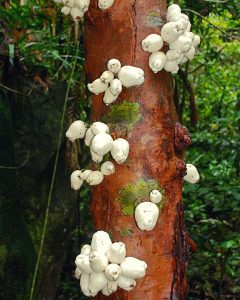Forest Flora – Daintree Satinash

Daintree Satinash (Credit: Dean Jewell Photography)
#ForestFlora – The Daintree Satinash (Syzygium monospermum) is part of the Myrtaceae family and is endemic, occurring in north-east Queensland. These trees can grow up to 17m tall and have reddish-brown, smooth bark, and provide a cosy home for ants, who live in hollows within the trunk (which they access via slits in the trunk). When fully mature the edible white fruit is usually around 36-41mm.
This beautiful tree flowers and fruits directly from its trunks or main branches. This unusual botanical trait is called cauliflory and the plants themselves are considered cauliflorous. The term is derived from the Latin ‘caulis’, meaning stem, and ‘flor’, meaning flower.
Fun Facts:
- Although the vegetable cauliflower (Brassica oleracea) has a similar name, it is not cauliflorous – the dense cluster of unopened flower buds that we eat arises from the main flower stalk.
- The Syzygium genus comprises about 1200 species and has a native range that extends from Africa and Madagascar through southern Asia east through the Pacific. Most species are evergreen trees and shrubs.
- Several species are grown as ornamental plants for their attractive glossy foliage, and a few produce edible fruits that are eaten fresh or used in jams and jellies. The most economically important species, however, is the clove Syzygium aromaticum, of which the unopened flower buds are an important spice.
- Fifty-two species of Syzygium are found in Australia and are generally known as Lilli Pilli’s, brush cherries or satinash.
Information sourced from Queensland Government and Wikipedia
Want more good Rainforest news in your life?
Subscribe to our eNews | Follow us on Instagram | Like us on Facebook | Subscribe to our YouTube channel
Help Protect Rainforests Forever
Donate to Protect Rainforests Forever | Become a Rainforest Guardian for as little as $2 a month | Partnership Options

